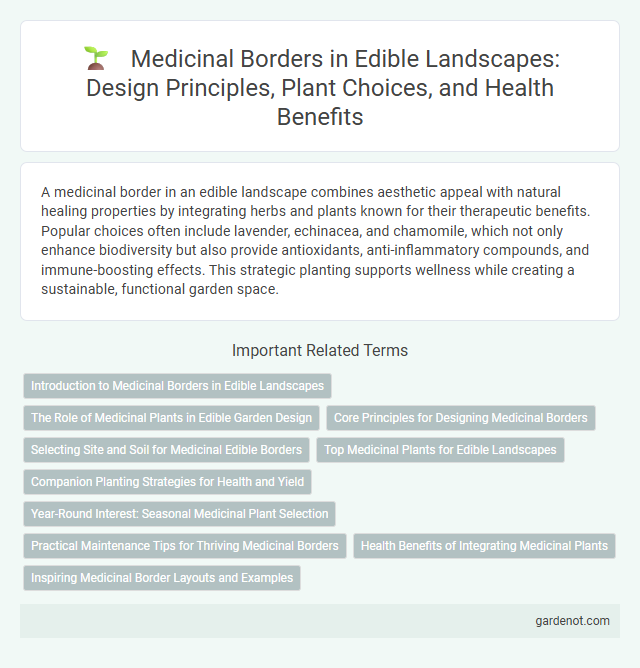A medicinal border in an edible landscape combines aesthetic appeal with natural healing properties by integrating herbs and plants known for their therapeutic benefits. Popular choices often include lavender, echinacea, and chamomile, which not only enhance biodiversity but also provide antioxidants, anti-inflammatory compounds, and immune-boosting effects. This strategic planting supports wellness while creating a sustainable, functional garden space.
Introduction to Medicinal Borders in Edible Landscapes
Medicinal borders in edible landscapes integrate healing plants such as echinacea, lavender, and chamomile to enhance both aesthetics and wellness. These borders support biodiversity by attracting pollinators and beneficial insects while providing natural remedies for common ailments. Incorporating medicinal plants creates multifunctional garden spaces that promote health, sustainability, and sensory engagement.
The Role of Medicinal Plants in Edible Garden Design
Medicinal plants play a crucial role in edible garden design by enhancing biodiversity and promoting natural wellness through homegrown remedies. Incorporating herbs like echinacea, chamomile, and lavender into the medicinal border not only supports pollinators but also provides accessible, organic treatment options for common ailments. Strategic placement of these plants maximizes both aesthetic appeal and functional health benefits within the edible landscape.
Core Principles for Designing Medicinal Borders
Designing medicinal borders requires selecting plants with proven therapeutic properties such as echinacea, calendula, and lavender to maximize health benefits. Incorporate principles of biodiversity and seasonal variation to ensure continuous availability of medicinal herbs throughout the year. Strategic layering of plants by height and function supports both aesthetics and accessibility for harvesting.
Selecting Site and Soil for Medicinal Edible Borders
Selecting an optimal site for medicinal edible borders involves prioritizing well-drained soil with a pH range of 6.0 to 7.0, ensuring nutrient-rich conditions to support diverse plant growth. Full to partial sunlight exposure enhances the potency of medicinal compounds in herbs, while avoiding areas prone to waterlogging prevents root rot and fungal diseases. Incorporating organic matter improves soil structure and moisture retention, creating a sustainable environment for thriving medicinal plants.
Top Medicinal Plants for Edible Landscapes
Top medicinal plants for edible landscapes include echinacea, renowned for its immune-boosting properties, and lavender, valued for its calming effects and culinary uses. Calendula offers anti-inflammatory benefits and vibrant blooms, making it both functional and decorative in garden borders. Incorporating peppermint enhances digestion and provides aromatic flavor, enriching the medicinal border with practical health advantages.
Companion Planting Strategies for Health and Yield
Companion planting strategies in medicinal borders enhance plant health and increase yield by leveraging natural pest control and nutrient sharing among compatible species such as calendula, chamomile, and lavender. These plants create a synergistic environment that boosts growth while reducing the need for chemical interventions, promoting a sustainable edible landscape. Integrating medicinal herbs with vegetables like tomatoes and peppers further supports resistance to diseases and improves overall garden productivity.
Year-Round Interest: Seasonal Medicinal Plant Selection
Selecting medicinal plants for a year-round edible landscape ensures continuous harvest and therapeutic benefits throughout all seasons. Incorporate diverse species like echinacea and chamomile for spring, calendula and yarrow in summer, valerian and ginseng in autumn, and mullein and peppermint during winter. This strategic seasonal medicinal plant selection enhances biodiversity, aesthetic appeal, and reliable access to natural remedies year-round.
Practical Maintenance Tips for Thriving Medicinal Borders
Regular pruning and removal of dead or diseased foliage help maintain air circulation, reducing the risk of fungal infections in medicinal borders. Consistent watering schedules tailored to the specific needs of each herb ensure healthy root development and prevent overwatering. Mulching with organic materials conserves moisture, suppresses weeds, and enriches the soil, promoting vigorous growth in medicinal plant borders.
Health Benefits of Integrating Medicinal Plants
Integrating medicinal plants into edible landscapes enhances natural wellness by providing anti-inflammatory, antioxidant, and immune-boosting properties directly from the garden. Plants such as echinacea, lavender, and chamomile contribute essential phytochemicals that support respiratory health, reduce stress, and promote digestion. This sustainable approach to landscaping not only beautifies spaces but also offers accessible, herbal remedies for holistic health.
Inspiring Medicinal Border Layouts and Examples
Inspiring medicinal border layouts integrate a diverse selection of healing plants such as echinacea, lavender, and calendula, arranged by height and bloom color to maximize both aesthetics and therapeutic benefits. Effective examples showcase layered planting with taller herbs like rosemary at the back and ground covers like chamomile in front, creating a visually appealing and functional space. These designs emphasize companion planting principles to enhance growth and medicinal potency while supporting pollinators.
Medicinal border Infographic

 gardenot.com
gardenot.com